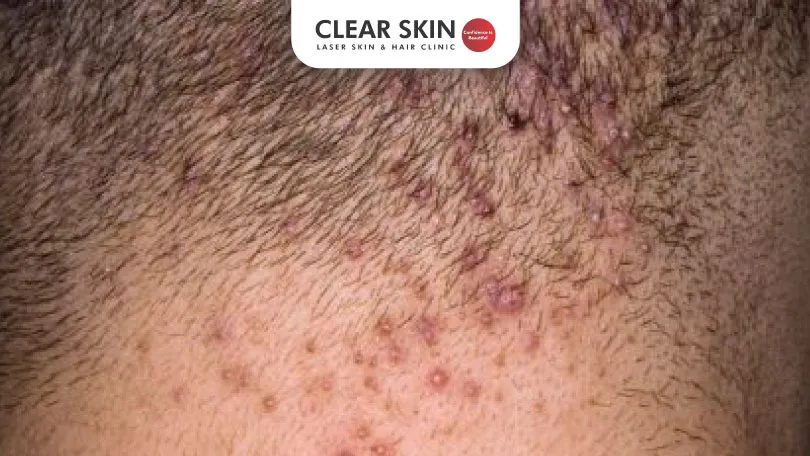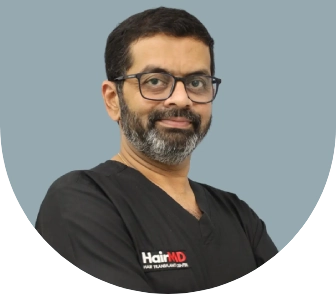Everything You Need to Know About Acne Keloidalis Nuchae
Reviewed By: ![]() Dr. Dhananjay Chavan
Dr. Dhananjay Chavan
Updated on: 11th April, 2023

Are you tired of battling persistent bumps and scars on your neck? Well, an all-too-familiar culprit is Acne Keloidalis. This stubborn skin condition can make you feel like you’re in an endless battle with your own body.
But fear not! We will delve into the intricacies of acne keloidalis nuchae, unravelling its causes, symptoms, and effective treatment options that will help you bid farewell to this unwelcome intruder once and for all.
Table Of Content
- Acne Keloidalis Nuchae: Meaning
- How does Acne Keloidalis Nuchae form?
- Symptoms to Look Out For
- Causes for the Formation of Acne Keloidalis Nuchae
- Methods of Treatment
- Tips for Reducing the Occurrence
- conclusion
Acne Keloidalis Nuchae: Meaning
Acne Keloidalis Nuchae is a chronic inflammatory skin condition. The other name for this is Keloidal Folliculitis (keloid – thick scar, folliculitis – inflammation of the hair follicle). This skin condition which results from some kind of trauma, friction or infection of the hair follicles causing them to get irritated and form scars.
The occurrence of Keloidal Folliculitis is commonly seen on the skin around the nape of the neck where sores or lesions develop. Later, these lesions turn into scars around the affected area. These sores have a certain resemblance to acne and are at times thick like Keloid scars. This resemblance is the reason for it being termed as Acne Keloidalis Nuchae.
Though both men and women can get affected, men are twenty times more likely to develop the disease. The skin affected by Keloidal Folliculitis usually has ingrown hair or ruptured hair shafts which trigger these lesions.
The scars that develop after the lesions subside are similar to the Keloid scars, meaning they are stiff and raised.
How does Acne Keloidalis Nuchae form?
Acne Keloidalis Nuchae occurs when the hair follicles at the nape of the neck are irritated by thick or ingrown hairs. This leads to the increased production of keratin and fibrin (skin proteins) leading to thickening of affected areas and formation of hard bumps or scars.
The skin condition is characterised by rupturing of the follicle wall of the hair strands. The rupture initiates the process of inflammation that tends to make the skin around the neck appear reddish. Later, as the inflammation subsides, the skin tissue becomes thickened and scarred. The process of scarring of the skin is termed as fibrosis.
Symptoms to Look Out For
The beginning of Keloidal Folliculitis is characterised by red and inflamed rashes that are known as papules.
The formation of these papules can be followed by an infection that can develop into pustules. The term pustules refers to certain pus filled blisters. This implies that if the papules get infected they turn into abscesses which are tender pus contained masses.
With time, the inflammation will give way to the formation of Keloid scars. These scars eventually come together to form what appears to be wide elevated areas of the skin.
Causes for the Formation of Acne Keloidalis Nuchae
The Medical fraternity is still unsure about the exact causes of Acne Keloidalis Nuchae. But certain dark skinned men with curly hair have been more likely to develop this skin condition than others. Although the exact reasons remain unknown, there are some probable causes of Acne Keloidalis Nuchae can be categorised as:
- Shaving- The nicks and cuts caused by close shaving may result in inflammation that can rupture the hair follicles. Mainly shaving in multiple directions makes the person more prone for acne keloidalis.
- Consistent Friction- Friction or irritation on the skin at the nape of the neck may be caused due to shirt collars that tug at the hair strands. This may cause Keloidal Folliculitis and eventually scarring. Hot and humid climates can potentially worsen the condition.
- Genetics- If a person possesses a certain genetic mutation that leads to weak follicle structure of hair, he can be more susceptible to Keloidal Folliculitis.
- Infection- Some chronic infections have also proven to play a role in the occurrence of Acne Keloidalis Nuchae.
Methods of Treatment
Depending on the severity of the condition, there are certain ways in which Keloidal Folliculitis can be treated:
- Topical Medication – The early and mild stages of the disease where the keloidal lesions are yet to appear, a combined use of topical steroids and retinoids can prove to be very effective.
- Cryotherapy – This is another useful method of treatment for this disease that is capable of treating both the early stages and the keloidal lesions. In this, the keloidal lesions are softened that make intralesional injections more effective.
- Systemic Therapy – It involves the long term consumption of antibiotics and retinoids for reducing the inflammation.
- Surgical Treatment – This method is applied for people who do not respond to the other forms of medical treatment.
- Laser Therapy – Laser treatment is often used with topical medication for gaining quicker and better results.
It’s advisable to consult an experienced dermatologist for proper acne treatment.
Tips for Reducing the Occurrence
Although there it is quite difficult to eradicate Acne Keloidalis Nuchae, there are some tips that can be used to keep it at bay:
- Maintaining hygiene and keeping the skin at the nape of the neck clean and dry can go a long way in preventing this skin condition.
- Eliminating the chances of friction on the skin by wearing collarless t-shirts and jackets can help to a great extent.
- Short or close shaves for various hair styles can cause damage to hair follicles. Thus, avoiding it may prove to be helpful.
- Avoid shaving or trimming the hair with a close trimmer – prefer cutting. While using a trimmer, it should be used in the direction of hair growth.
- Avoiding the use of hair gels and other similar products will help in proper hair growth.
- Conditioners should be used for softening the hair at the nape of the neck.
- Using retinoids or exfoliants can be helpful.
Do You Know?
Roughly 250 Patients Are Treated
Everyday By These Dermatologists
(You are one click away from flawless skin)
Meet Our Dermatologist!
Conclusion
Although there is no exact known cure for acne keloidalis nuchae, avoiding friction over the area and seeking medical help in the early stages can aid in preventing the progression of disease and in a faster resolution of this condition.
Book your consultation with our expert dermatologists at Clear Skin Clinics for proper diagnosis and treatment of acne kelodalis nuchae.
Further Reading
Does Laser Work on Scars?
Explore effective laser scar treatments like PRP, microneedling, and CO2 laser at Clearskin Clinic Pune for smoother skin and improved texture.
Cost of Laser Hair Reduction
Explore the benefits, cost factors, and advanced technologies in laser hair reduction. Visit Clear Skin Clinic Pune for expert treatments and smoother skin.
Can you Control Oily Skin?
Find out if coffee causes acne & how it affects your skin. Talk to the experts at Clear Skin Clinic in Pune for personalized acne treatment.
Coffee and Acne: Uncovering the Truth Behind the Breakouts
Find out if coffee causes acne & how it affects your skin. Talk to the experts at Clear Skin Clinic in Pune for personalized acne treatment.
Have thoughts? Please let us know
We are committed not only to treating you, but also educating you.






